Effect of Joint Characteristics and Geometries on Tunnel-Type Anchorage for Suspension Bridge
Abstract
:1. Introduction
2. Numerical Analysis
2.1. Finite Element Mesh and Boundary
2.2. Material Parameters and Interface Modeling
2.3. Parametric Study
3. Results and Discussion—Geometric Conditions
3.1. Effect of the Enlarged Part
3.2. Effect of Anchorage Spacing
4. Results and Discussion—Joint Characteristics
4.1. Effect of Joint Orientation
4.2. Effect of Joint Spacing
4.3. Effect of Strength Properties on the Joint Surface
5. Conclusions
- (1)
- When there was no enlarged part in the tunnel-type anchorage, the anchorage showed a pull-out failure mode; however, if there was an enlarged part, it showed a wedge-shaped failure mode. Additionally, it was confirmed that the pull-out resistance of the anchorage decreased as the spacing between the anchorages became narrower, similar to the group effect of the pile.
- (2)
- It was found that the lowest resistance was shown when the tunnel-type anchorage was constructed on the rock with the joints in the direction perpendicular to the cable load. The reason for this could be that the joint direction is similar to the wedge shape, which is a typical failure mode of the tunnel-type anchorage.
- (3)
- It was found that the ultimate load increased as the joint spacing became wider because the weight of the rock between the joints increased, and the number of joints decreased. In the pull-out behavior of the tunnel-type anchorage, the internal friction angle of the joint was more significant than the cohesion between the joints.
Author Contributions
Funding
Institutional Review Board Statement
Informed Consent Statement
Data Availability Statement
Conflicts of Interest
References
- Lekidis, V.; Tsakiri, M.; Makra, K.; Karakostas, C.; Klimis, N. Evaluation of dynamic response and local soil effects of the Evripos cable-stayed bridge using multi-sensor monitoring systems. Eng. Geol. 2005, 79, 43–59. [Google Scholar] [CrossRef]
- Gwon, S.G.; Choi, D.H. Static and dynamic analyses of a suspension bridge with three-dimensionally curved main cables using a continuum model. Eng. Struct. 2018, 161, 250–264. [Google Scholar] [CrossRef]
- Han, Y.; Liu, X.; Wei, N.; Li, D.; Deng, Z.; Wu, X.; Liu, D. A Comprehensive Review of the Mechanical Behavior of Suspension Bridge Tunnel-Type Anchorage. Adv. Mater. Sci. Eng. 2019, 2019, 3829281. [Google Scholar] [CrossRef] [Green Version]
- Deng, Y.; Li, A.; Chen, S.; Feng, D. Serviceability assessment for long-span suspension bridge based on deflection measurements. Struct. Control. Health Monit. 2018, 25, 1–23. [Google Scholar] [CrossRef]
- Lim, H.; Seo, S.; Lee, S.; Chung, M. Analysis of the passive earth pressure on a gravity-type anchorage for a suspension bridge. Int. J. Geo-Eng. 2020, 11, 13. [Google Scholar] [CrossRef]
- Liu, X.; Han, Y.; Li, D.; Tu, Y.; Deng, Z.; Yu, C.; Wu, X. Anti-pull mechanisms and weak interlayer parameter sensitivity analysis of tunnel-type anchorages in soft rock with underlying weak interlayers. Eng. Geol. 2019, 253, 123–136. [Google Scholar] [CrossRef]
- Goremikins, V.; Rocens, K.; Serdjuks, D. Decreasing displacements of prestressed suspension bridge. J. Civ. Eng. Manag. 2012, 18, 858–866. [Google Scholar] [CrossRef]
- Sgambi, L.; Gkoumas, K.; Bontempi, F. Genetic algorithms for the dependability assurance in the design of a long-span suspension bridge. Comput. -Aided Civ. Infrastruct. Eng. 2012, 27, 655–675. [Google Scholar] [CrossRef]
- Harris, N.K.; Obrien, E.J.; González, A. Reduction of bridge dynamic amplification through adjustment of vehicle suspension damping. J. Sound Vib. 2007, 302, 471–485. [Google Scholar] [CrossRef] [Green Version]
- Yi, T.H.; Li, H.N.; Gu, M. Full-scale measurements of dynamic response of suspension bridge subjected to environmental loads using gps technology. Sci. China-Technol. Sci. 2010, 53, 469–479. [Google Scholar] [CrossRef]
- Comanducci, G.; Ubertini, F.; Materazzi, A.L. Structural health monitoring of suspension bridges with features affected by changing wind speed. J. Wind. Eng. Ind. Aerodyn. 2015, 141, 12–26. [Google Scholar] [CrossRef]
- Xia, Q.; Xia, Y.; Wan, H.P.; Zhang, J.; Ren, W.X. Condition analysis of expansion joints of a long-span suspension bridge through metamodel-based model updating considering thermal effect. Struct. Control. Health Monit. 2020, 27, 1–16. [Google Scholar] [CrossRef]
- Jiang, N.; Wang, D.; Feng, J.; Zhang, S.; Huan, L. Bearing mechanism of a tunnel-type anchorage in a railway suspension bridge. J. Mt. Sci. 2021, 18, 2143–2158. [Google Scholar] [CrossRef]
- Meyerhof, G.G. Uplift resistance of inclined anchors and piles. In Proceedings of the 8th International Conference on Soil Mechanics and Foundation Engineering, Moscow, Russia, 6–11 August 1973. [Google Scholar]
- Das, B.M. A procedure for estimation of uplift capacity of rough piles. Soils Found. 1983, 23, 122–126. [Google Scholar] [CrossRef] [Green Version]
- Aydan, Ö.; Ebisu, S.; Komura, S. Pull-out tests of rock anchors and their failure modes. In Assessment and Prevention of Failure Phenomena in Rock Engineering; CRC Press: Istanbul, Turkey, 1993. [Google Scholar]
- Shanker, K.; Basudhar, P.K.; Patra, N.R. Uplift capacity of single piles: Predictions and performance. Geotech. Geol. Eng. 2007, 25, 151–161. [Google Scholar] [CrossRef]
- Alawneh, A.S.; Malkawi, A.I.H.; Al-Deeky, H. Tension tests on smooth and rough model piles in dry sand. Can. Geotech. J. 1999, 36, 746–753. [Google Scholar] [CrossRef]
- Ilamparuthi, K.; Dickin, E.A.; Muthukrisnaiah, K. Experimental investigation of the uplift behaviour of circular plate anchors embedded in sand. Can. Geotech. J. 2002, 39, 648–664. [Google Scholar] [CrossRef]
- Lee, N.H.; Moon, I.H.; Ju, I.S. Failure mechanism for large-sized grouted anchor bolt under tensile load. In Proceedings of the 16th International Conference on Structural Mechanics in Reactor Technology, Washington, DC, USA, 12–17 August 2001. [Google Scholar]
- Azam, S.; Wilson, G.W.; Herasymuik, G.; Nichol, C.; Barbour, L.S. Hydrogeological behaviour of an unsaturated waste rock pile: A case study at the Golden Sunlight Mine. Bull. Eng. Geol. Environ. 2007, 66, 259–268. [Google Scholar] [CrossRef]
- Moayedi, H.; Mosallanezhad, M. Uplift resistance of belled and multi-belled piles in loose sand. Measurement 2017, 109, 346–353. [Google Scholar] [CrossRef]
- Albusoda, B.S.; Abbase, H.O. Performance assessment of single and group of helical piles embedded in expansive soil. Int. J. Geo-Eng. 2017, 8, 25. [Google Scholar] [CrossRef] [Green Version]
- Seo, S.; Lim, H.; Chung, M. Evaluation of failure mode of tunnel-type anchorage for a suspension bridge via scaled model tests and image processing. Geomech. Eng. 2021, 24, 457–470. [Google Scholar]
- PLAXIS. PLAXIS 3D Reference Manual; Bentley: Exton, PA, USA, 2020. [Google Scholar]
- Yooshin Co., Ltd. Ulsan Grand Bridge and Access Road Private Proposal Project: Basic Design Report (in Korean); Yooshin Co., Ltd.: Seoul, Korea, 2010. [Google Scholar]
- Yooshin Co., Ltd. Ulsan Grand Bridge and Access Road Private Proposal Project: Geotechnical Soil Report (in Korean); Yooshin Co., Ltd.: Seoul, Korea, 2010. [Google Scholar]

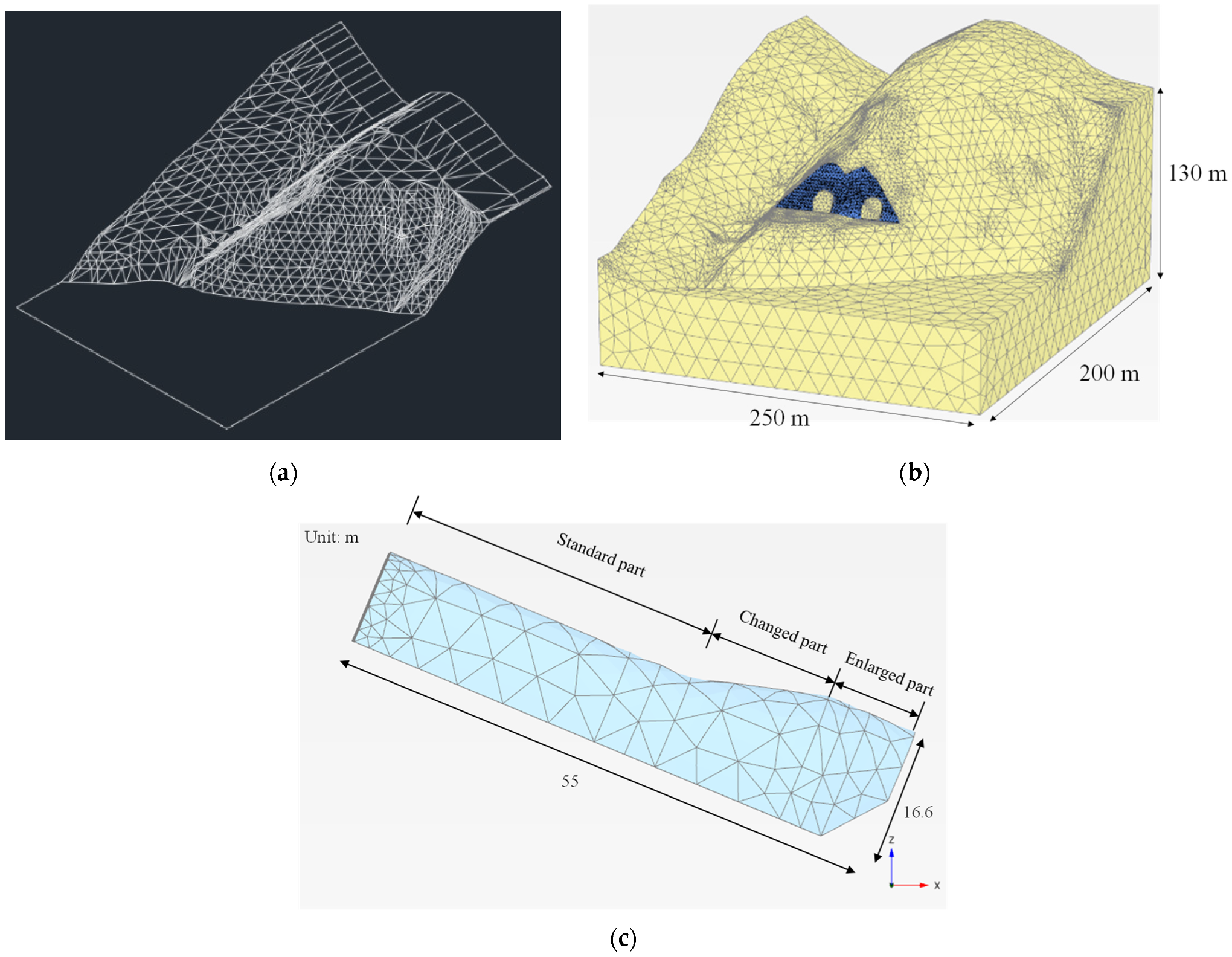

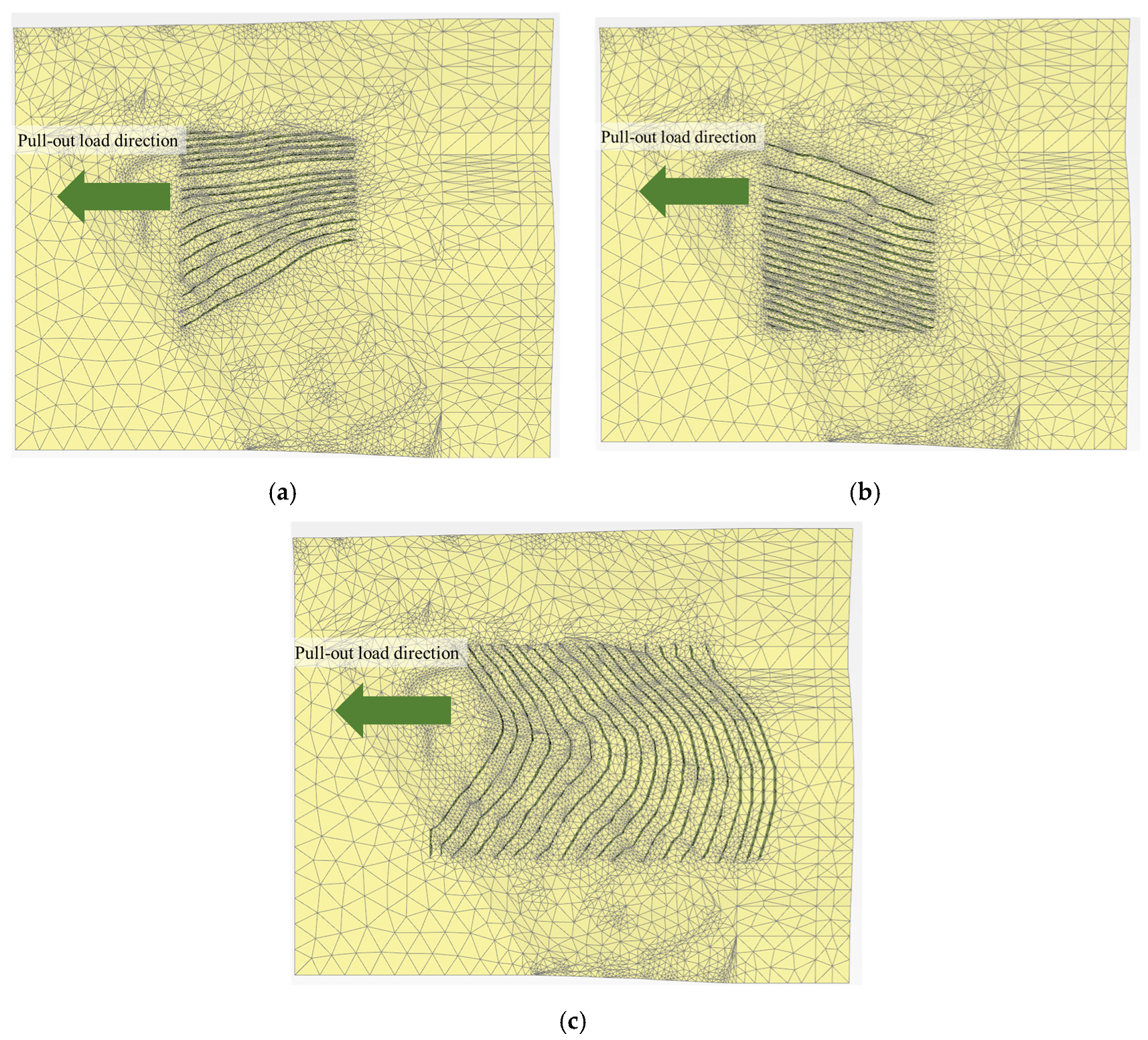

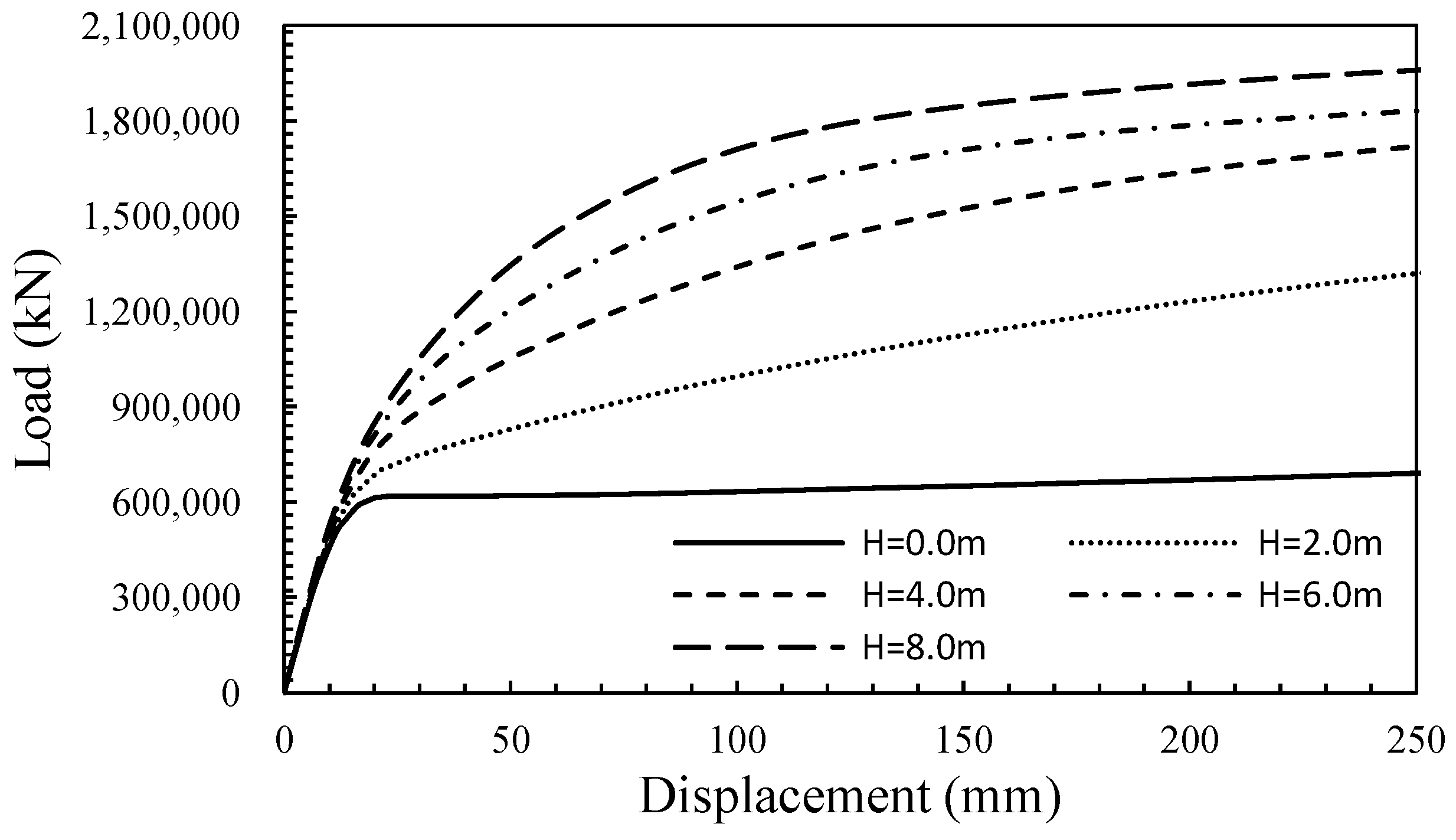
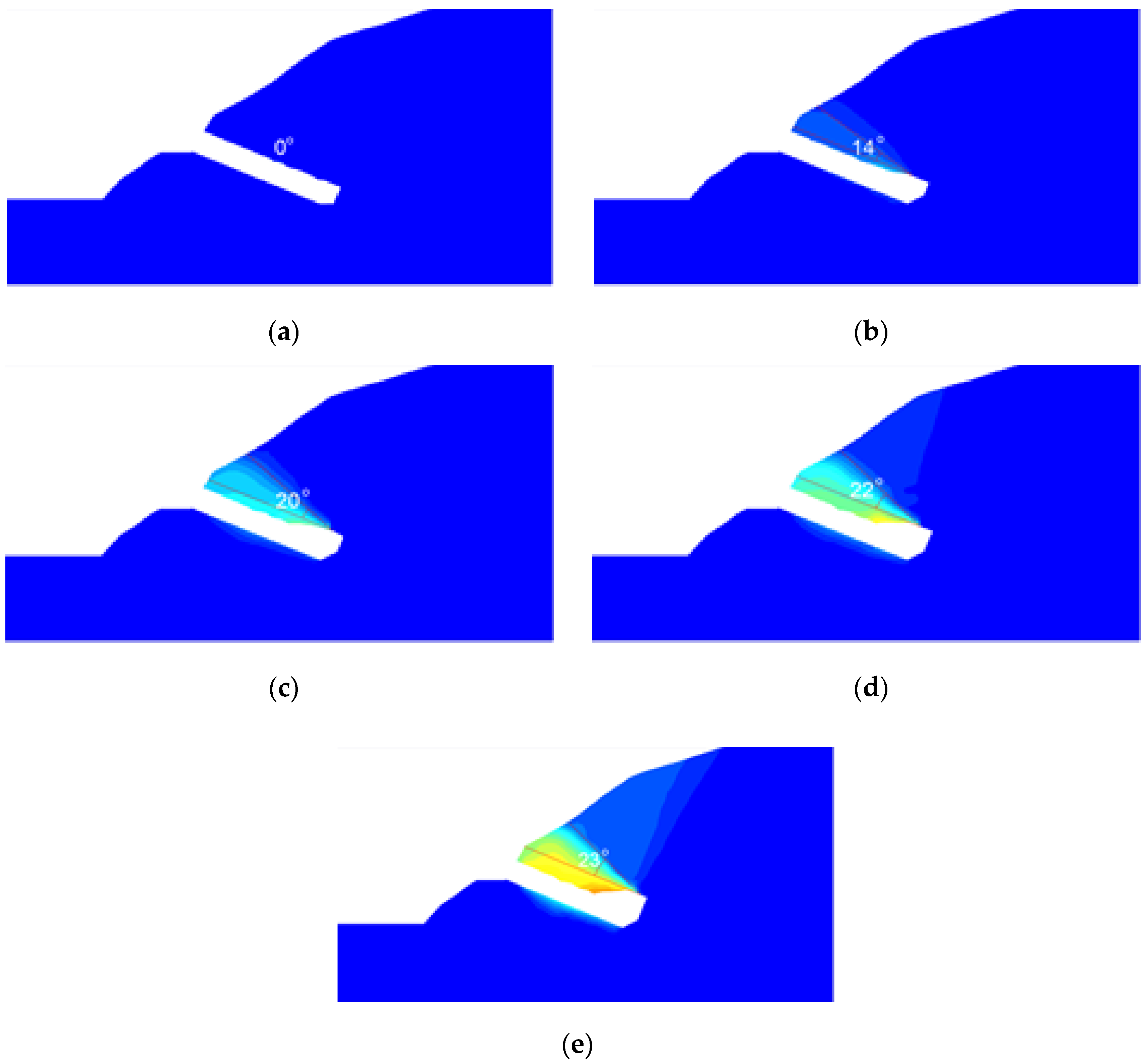

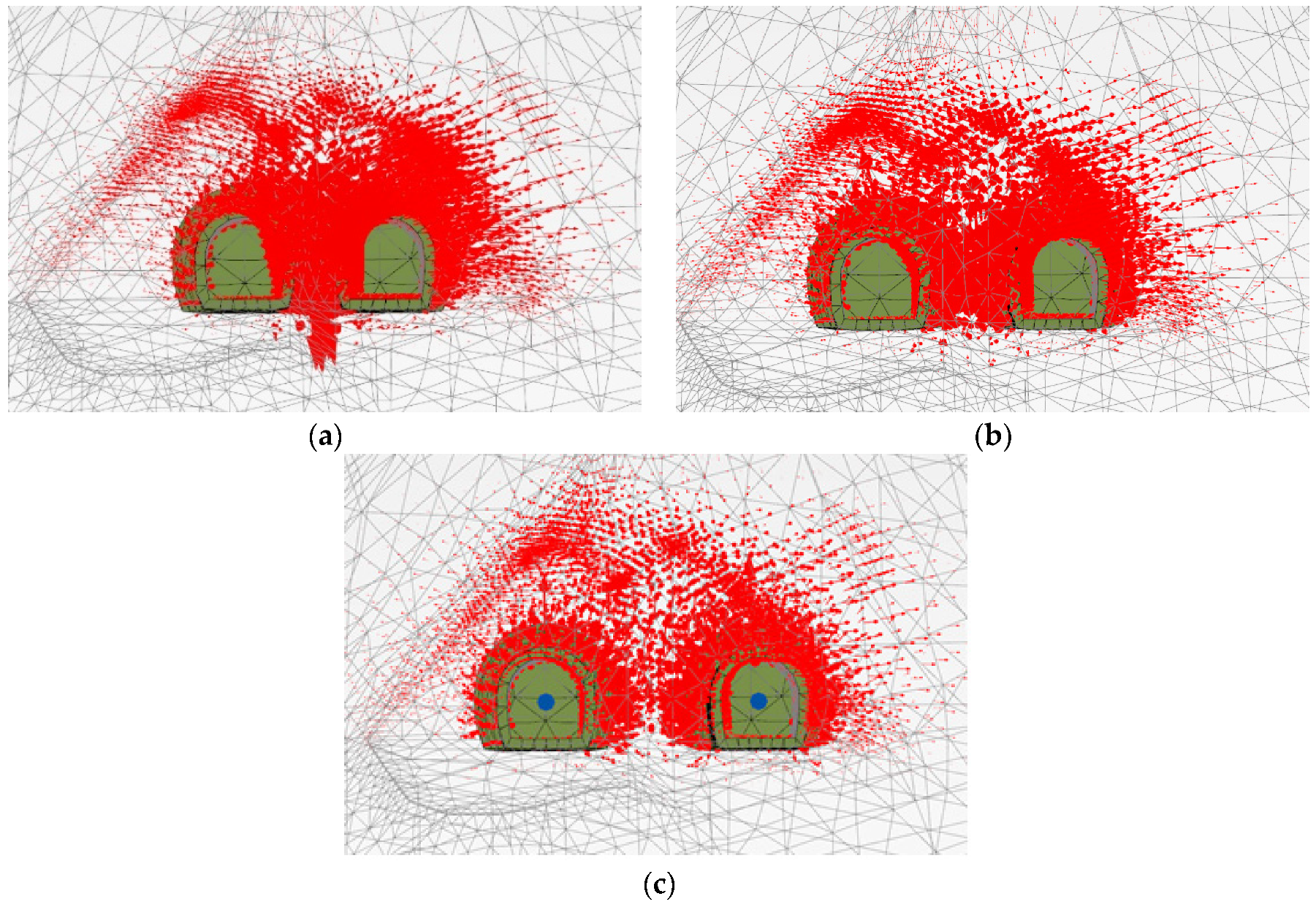
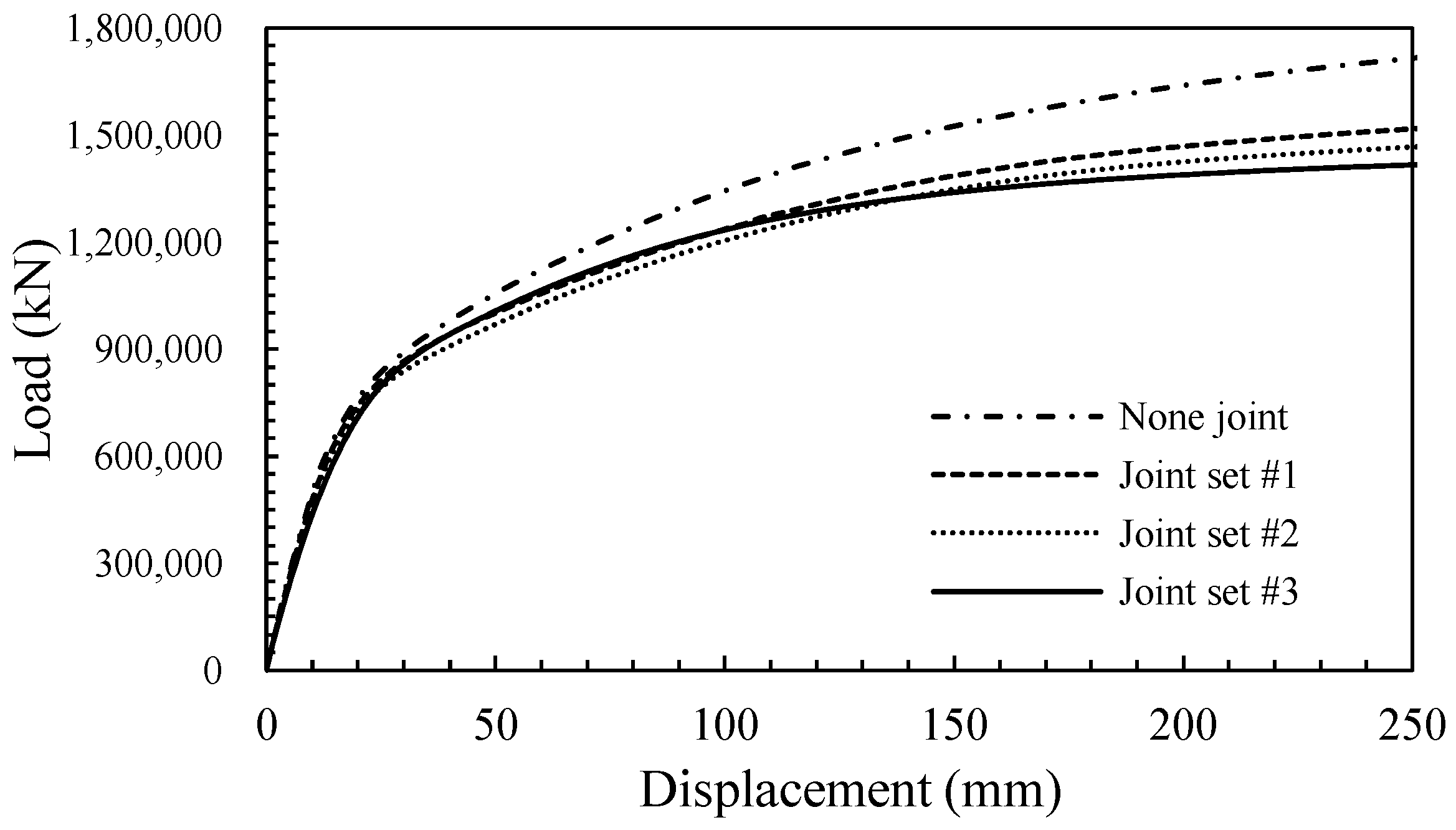
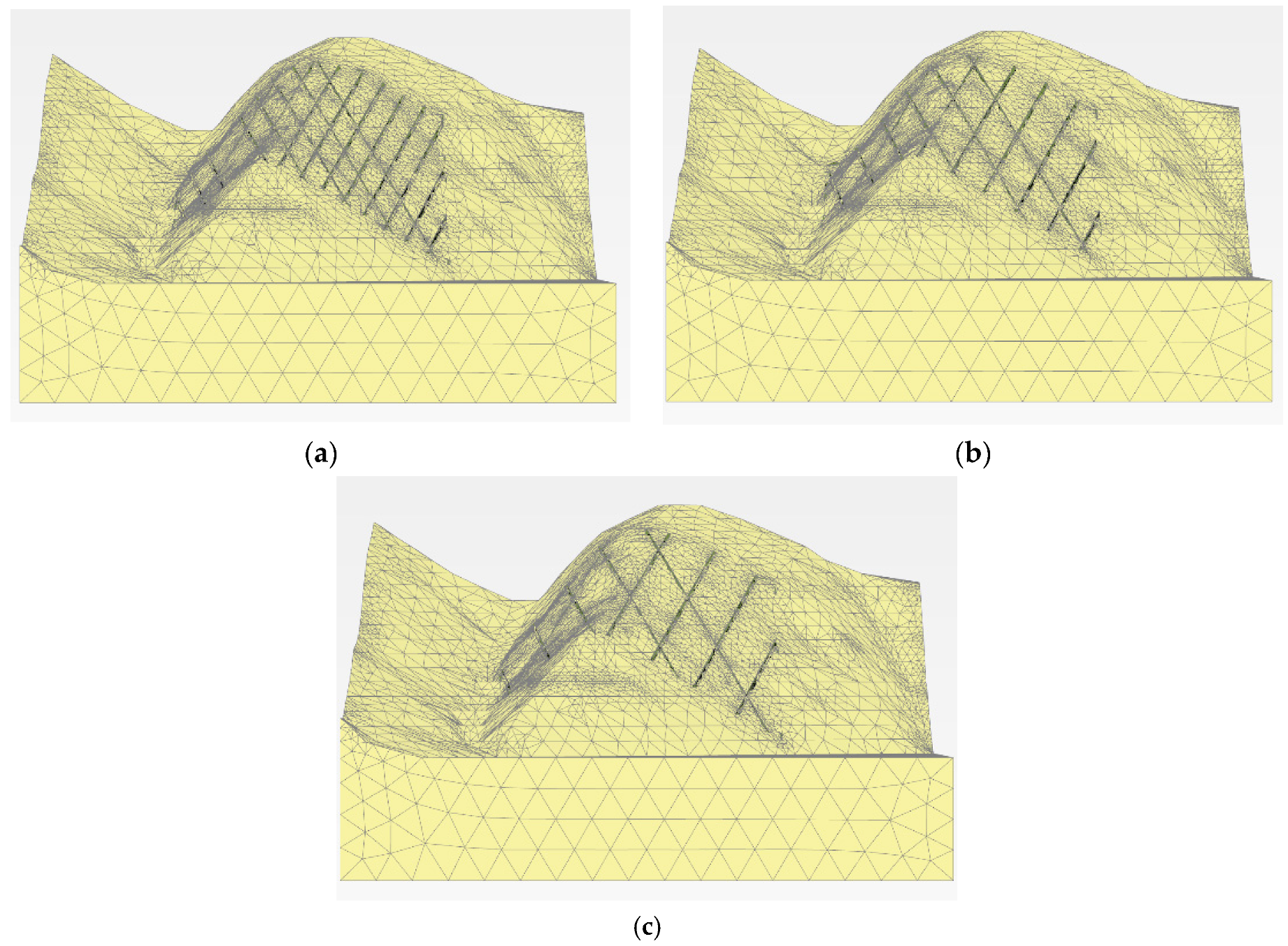
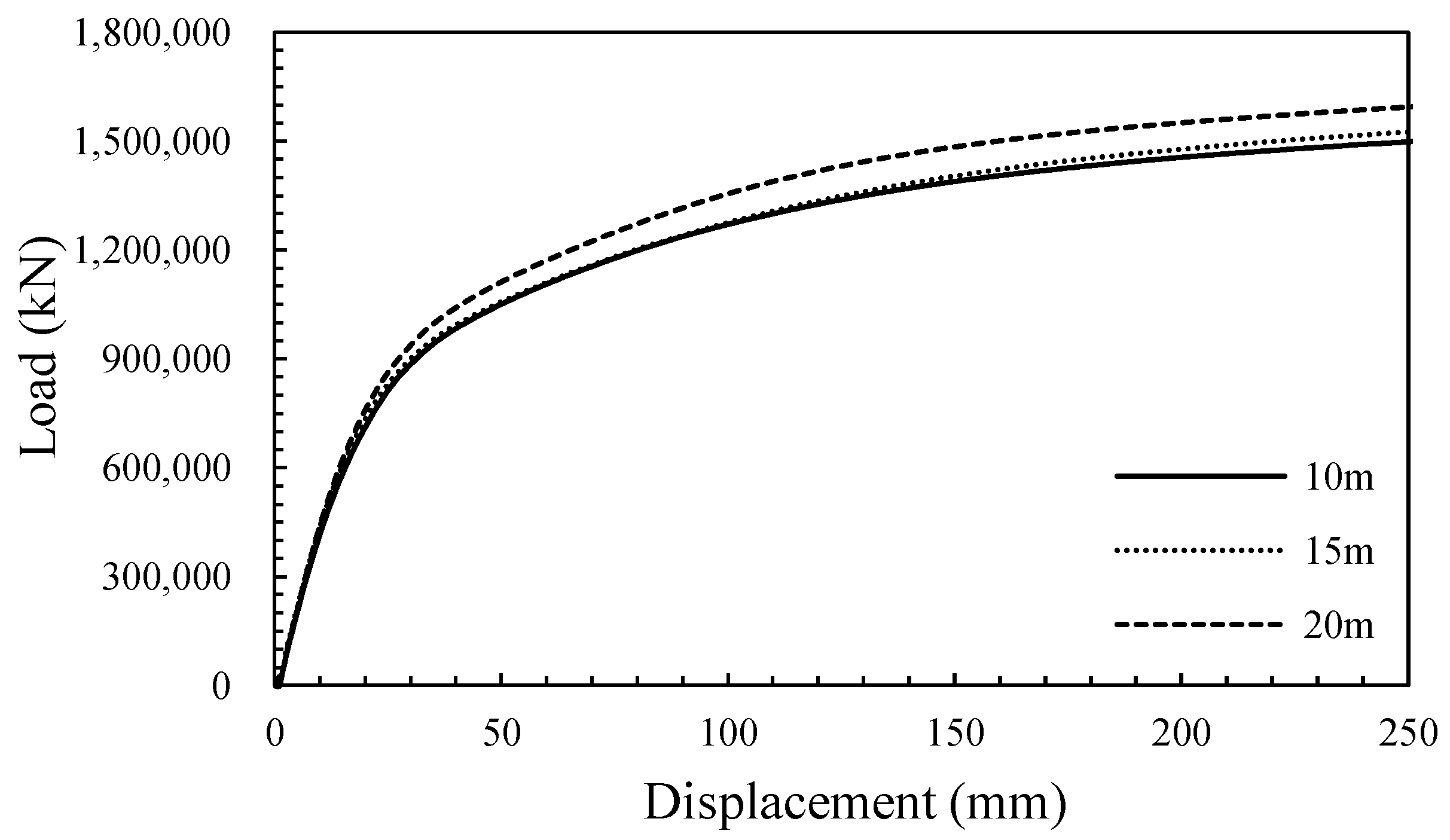
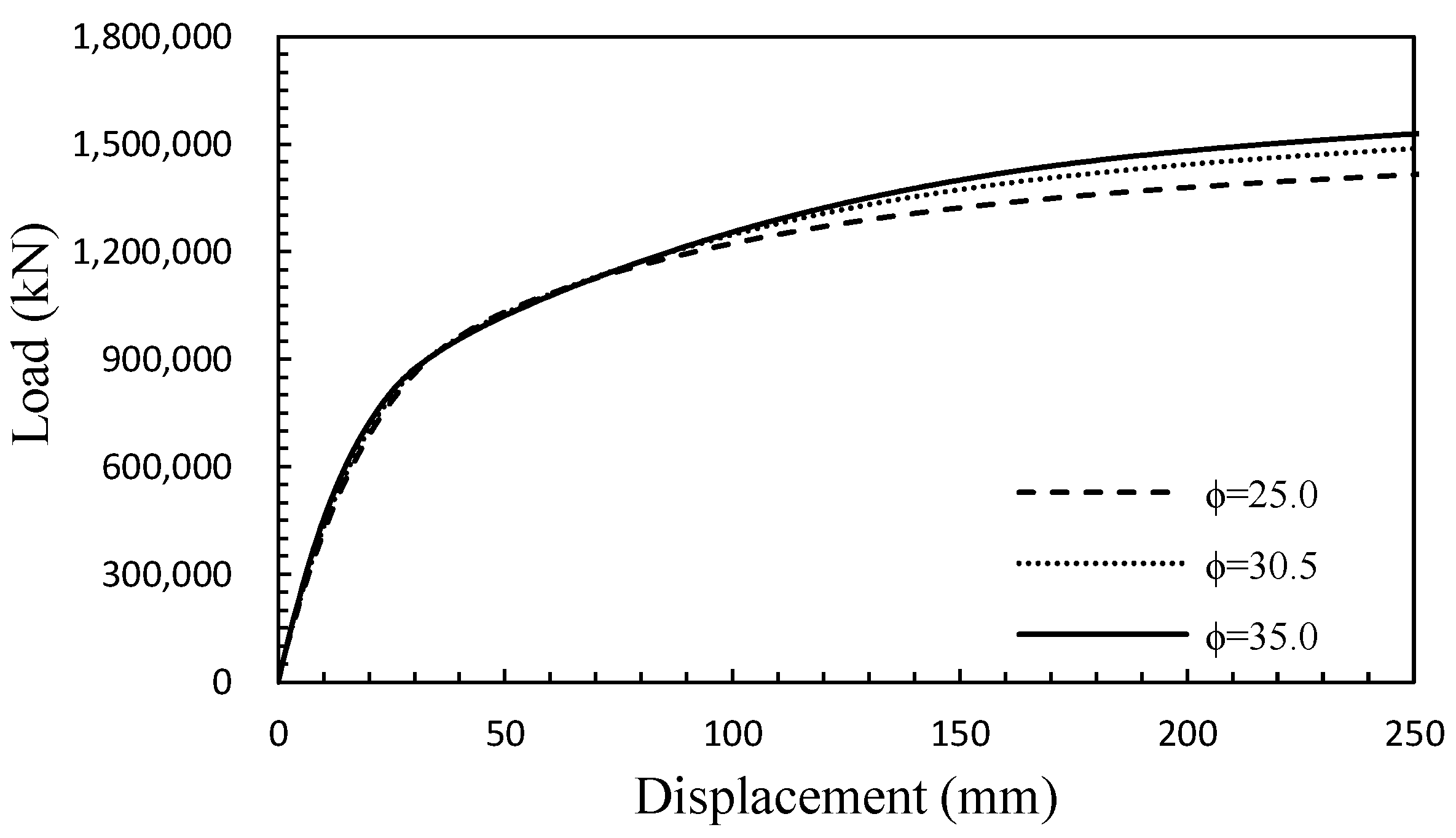
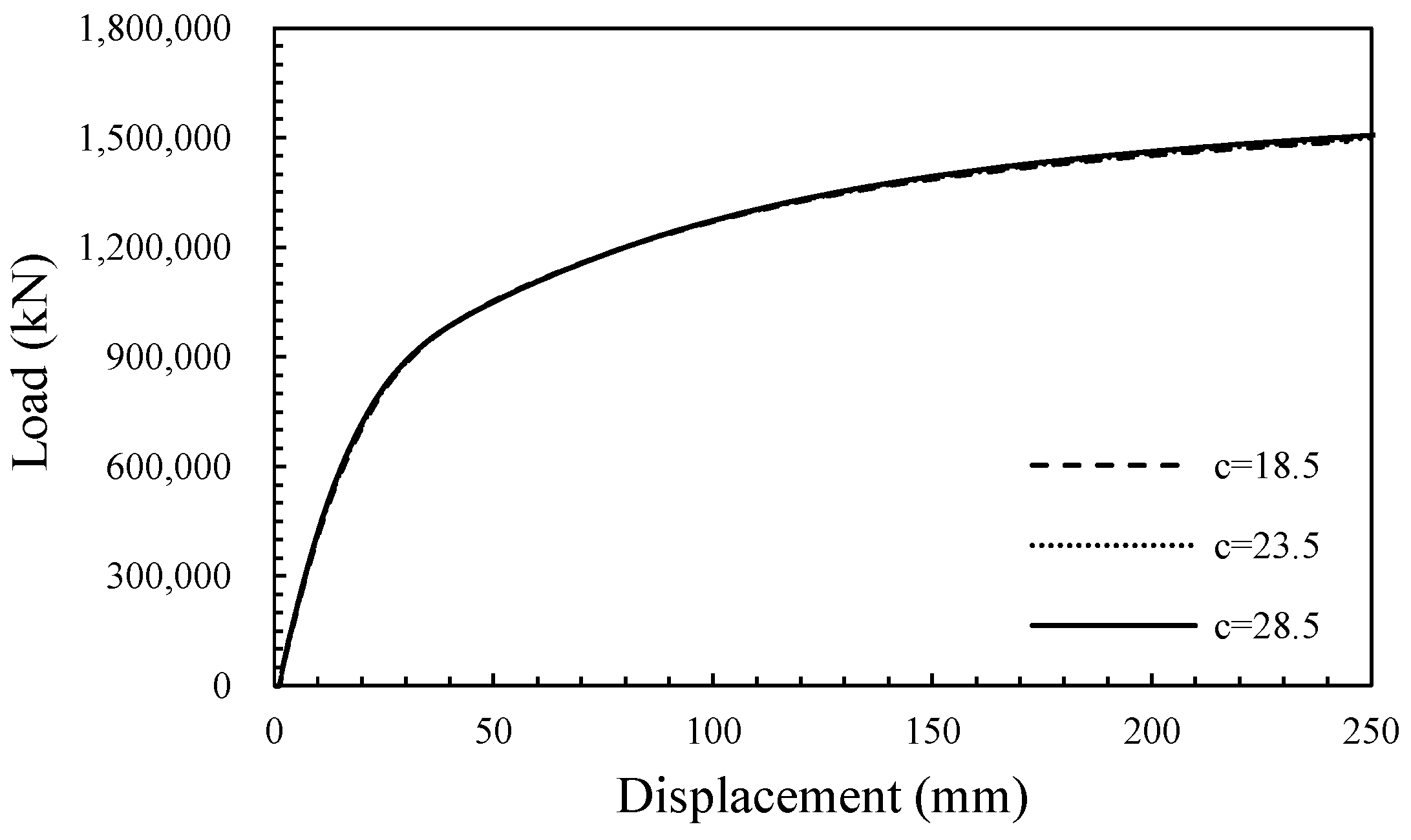
| Material Type | Unit Weight (kN/m3) | Elastic Modulus (kN/m2) | Poisson’s Ratio | Cohesion (kN/m2) | Internal Friction Angle (°) |
|---|---|---|---|---|---|
| Soil | 18.0 | 20,000 | 0.35 | 10 | 30.0 |
| Rock | 22.0 | 1,101,000 | 0.25 | 200 | 33.0 |
| Joint Sets Applied | Dip/Dip Direction | Cohesion (kN/m2) | Internal Friction Angle (°) | Kn (MPa) | Ks (MPa) |
|---|---|---|---|---|---|
| Joint set #1 | 60/162 | 23.5 | 30.5 | 8.96 | 0.78 |
| Joint set #2 | 60/342 | 23.5 | 30.5 | 13.04 | 0.87 |
| Joint set #3 | 55/252 | 23.5 | 30.5 | 13.32 | 0.89 |
| Parameters | Cases |
|---|---|
| Enlarged part (m) | 0, 2, 4, 6, and 8 |
| Anchorage spacing (m) | 18.5(1.7D), 23.5(2.2D), and 28.5(2.6D) |
| Joint dip/dip direction | 60/162, 60/342, and 55/252 |
| Joint spacing (m) | s: 10, 15, and 20 |
| Cohesion for rock joint (kPa) | c: 18.5, 23.5, and 33.5 |
| Internal friction angle for rock joint (°) | ϕ: 25, 30.5, and 35 |
Publisher’s Note: MDPI stays neutral with regard to jurisdictional claims in published maps and institutional affiliations. |
© 2021 by the authors. Licensee MDPI, Basel, Switzerland. This article is an open access article distributed under the terms and conditions of the Creative Commons Attribution (CC BY) license (https://creativecommons.org/licenses/by/4.0/).
Share and Cite
Lim, H.; Seo, S.; Ko, J.; Chung, M. Effect of Joint Characteristics and Geometries on Tunnel-Type Anchorage for Suspension Bridge. Appl. Sci. 2021, 11, 11688. https://doi.org/10.3390/app112411688
Lim H, Seo S, Ko J, Chung M. Effect of Joint Characteristics and Geometries on Tunnel-Type Anchorage for Suspension Bridge. Applied Sciences. 2021; 11(24):11688. https://doi.org/10.3390/app112411688
Chicago/Turabian StyleLim, Hyunsung, Seunghwan Seo, Junyoung Ko, and Moonkyung Chung. 2021. "Effect of Joint Characteristics and Geometries on Tunnel-Type Anchorage for Suspension Bridge" Applied Sciences 11, no. 24: 11688. https://doi.org/10.3390/app112411688
APA StyleLim, H., Seo, S., Ko, J., & Chung, M. (2021). Effect of Joint Characteristics and Geometries on Tunnel-Type Anchorage for Suspension Bridge. Applied Sciences, 11(24), 11688. https://doi.org/10.3390/app112411688







